High Rates of Sexually Transmitted Infections in Remote Parts of Australia: A Briefing Paper
VerifiedAdded on 2023/06/07
|14
|3794
|254
AI Summary
This briefing paper addresses the existing problem of high rates of sexually transmitted diseases in the remote parts of Australia especially northern Queensland, with recommendations for improvement.
Contribute Materials
Your contribution can guide someone’s learning journey. Share your
documents today.
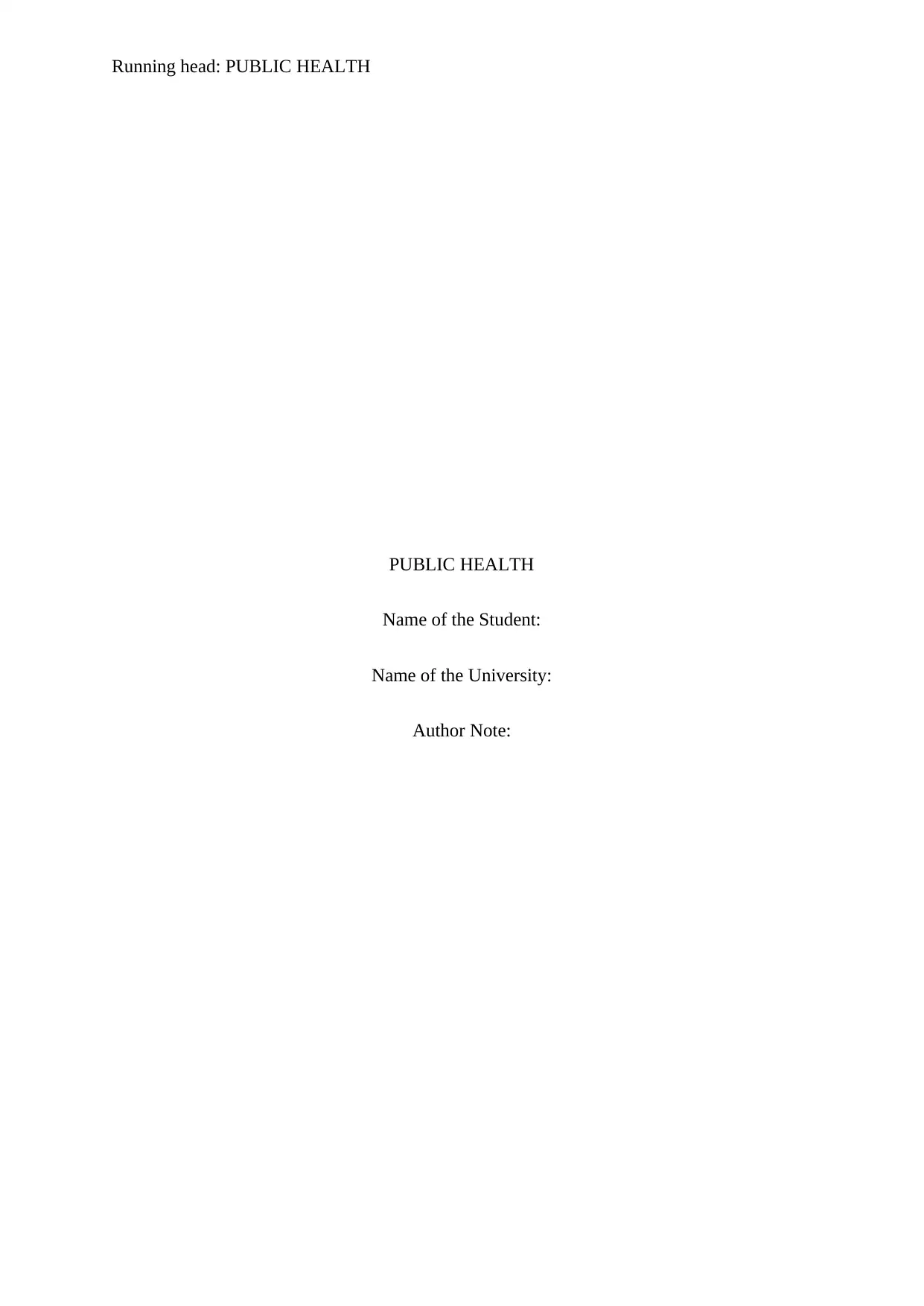
Running head: PUBLIC HEALTH
PUBLIC HEALTH
Name of the Student:
Name of the University:
Author Note:
PUBLIC HEALTH
Name of the Student:
Name of the University:
Author Note:
Secure Best Marks with AI Grader
Need help grading? Try our AI Grader for instant feedback on your assignments.
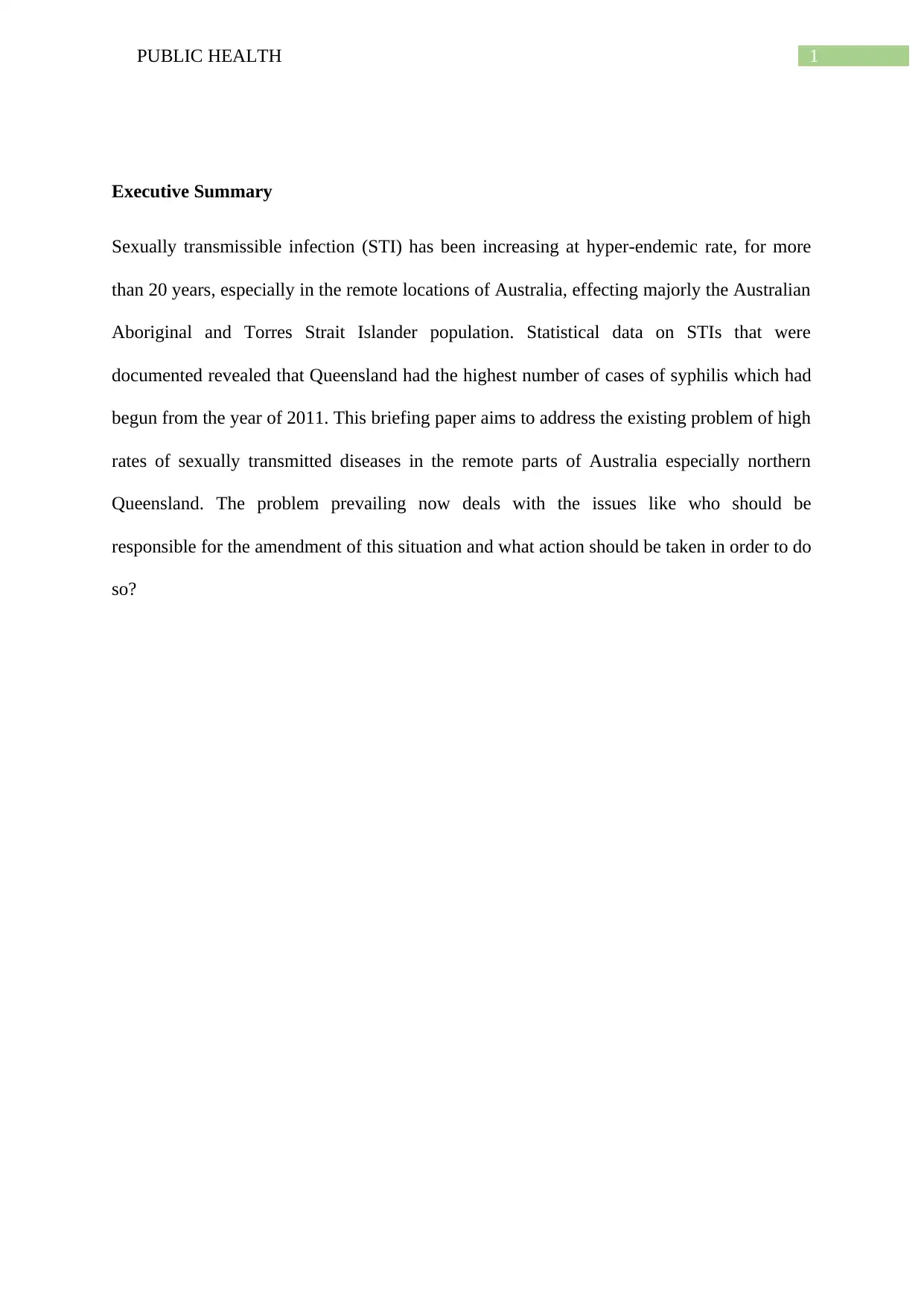
1PUBLIC HEALTH
Executive Summary
Sexually transmissible infection (STI) has been increasing at hyper-endemic rate, for more
than 20 years, especially in the remote locations of Australia, effecting majorly the Australian
Aboriginal and Torres Strait Islander population. Statistical data on STIs that were
documented revealed that Queensland had the highest number of cases of syphilis which had
begun from the year of 2011. This briefing paper aims to address the existing problem of high
rates of sexually transmitted diseases in the remote parts of Australia especially northern
Queensland. The problem prevailing now deals with the issues like who should be
responsible for the amendment of this situation and what action should be taken in order to do
so?
Executive Summary
Sexually transmissible infection (STI) has been increasing at hyper-endemic rate, for more
than 20 years, especially in the remote locations of Australia, effecting majorly the Australian
Aboriginal and Torres Strait Islander population. Statistical data on STIs that were
documented revealed that Queensland had the highest number of cases of syphilis which had
begun from the year of 2011. This briefing paper aims to address the existing problem of high
rates of sexually transmitted diseases in the remote parts of Australia especially northern
Queensland. The problem prevailing now deals with the issues like who should be
responsible for the amendment of this situation and what action should be taken in order to do
so?
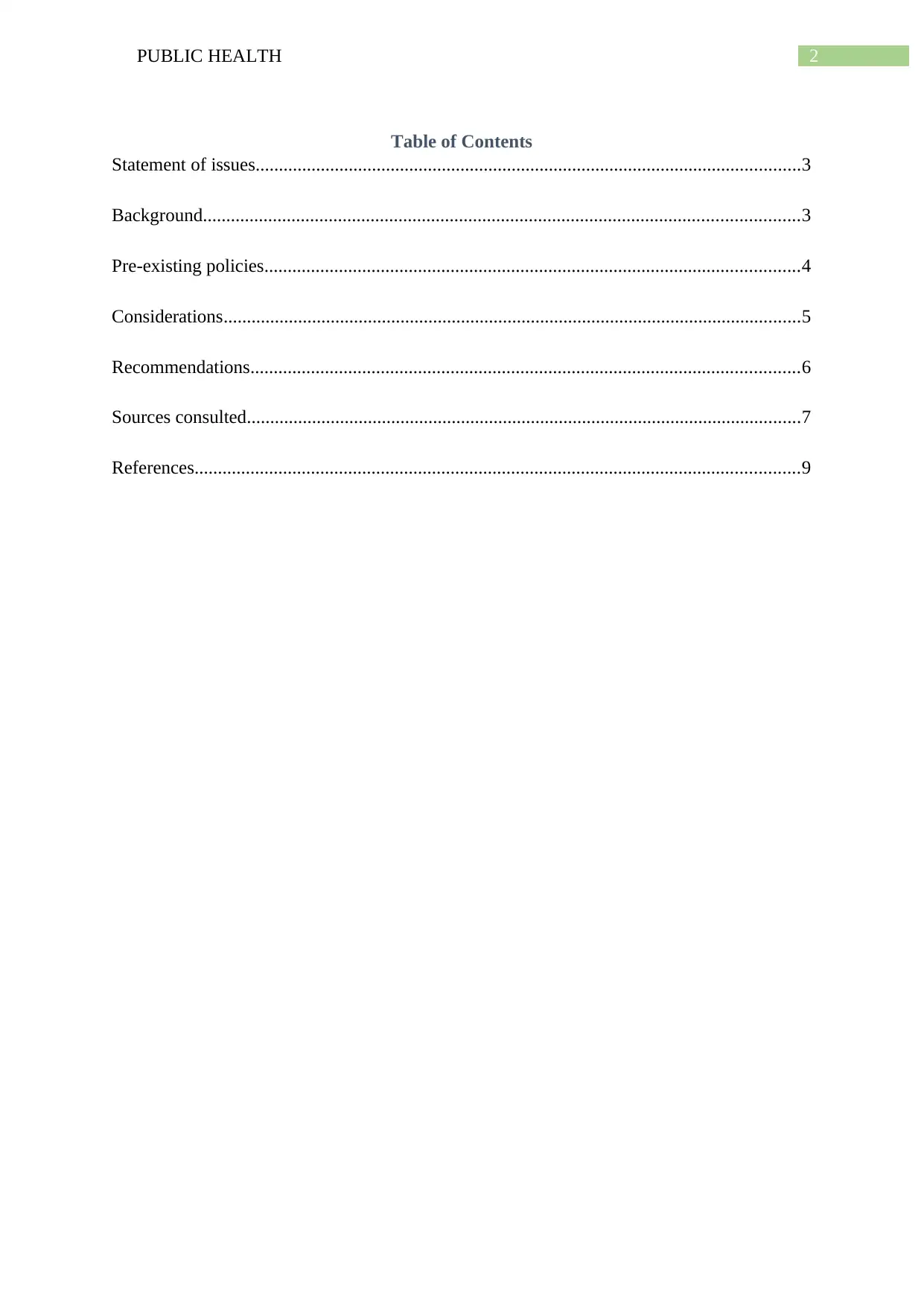
2PUBLIC HEALTH
Table of Contents
Statement of issues.....................................................................................................................3
Background................................................................................................................................3
Pre-existing policies...................................................................................................................4
Considerations............................................................................................................................5
Recommendations......................................................................................................................6
Sources consulted.......................................................................................................................7
References..................................................................................................................................9
Table of Contents
Statement of issues.....................................................................................................................3
Background................................................................................................................................3
Pre-existing policies...................................................................................................................4
Considerations............................................................................................................................5
Recommendations......................................................................................................................6
Sources consulted.......................................................................................................................7
References..................................................................................................................................9
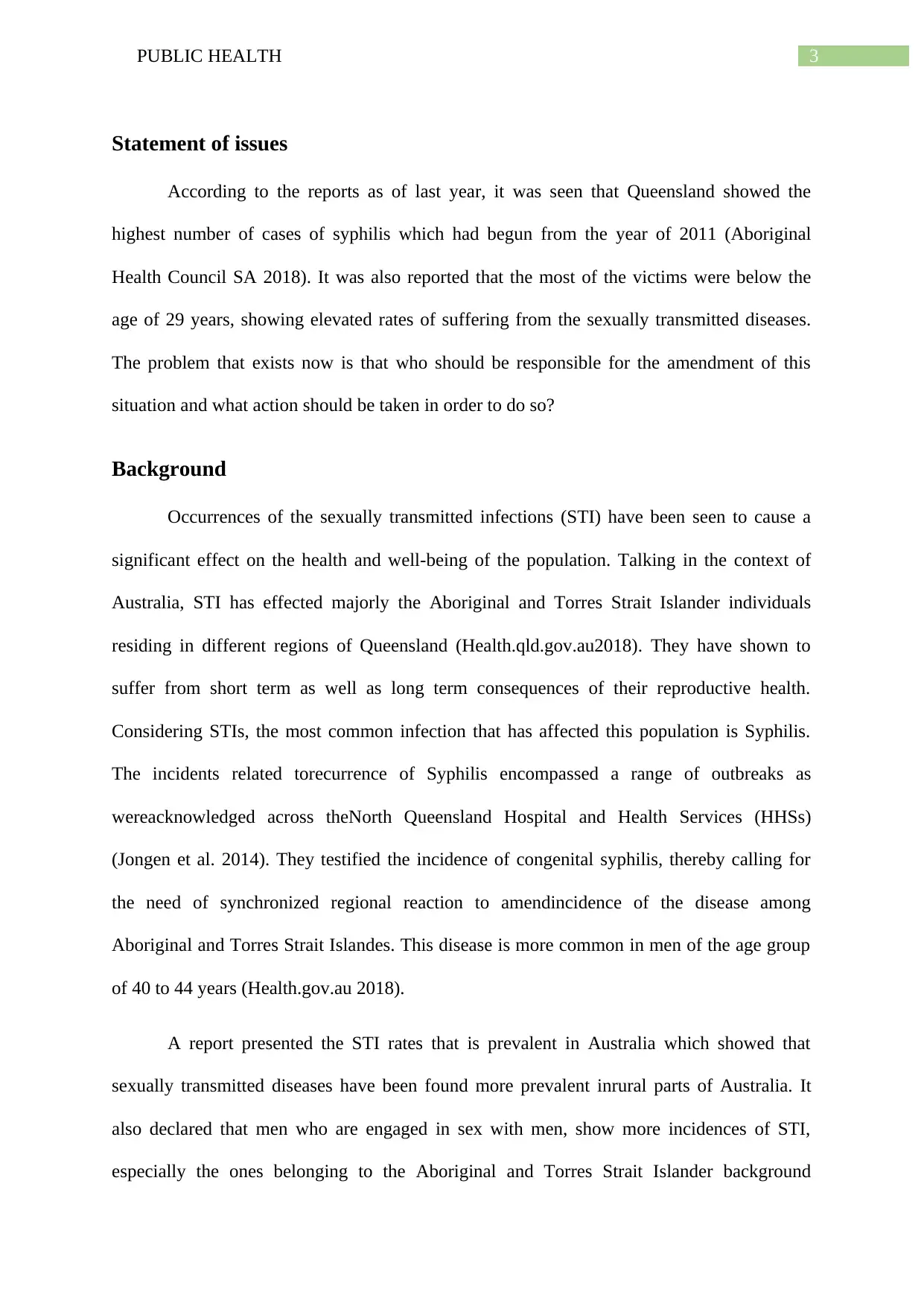
3PUBLIC HEALTH
Statement of issues
According to the reports as of last year, it was seen that Queensland showed the
highest number of cases of syphilis which had begun from the year of 2011 (Aboriginal
Health Council SA 2018). It was also reported that the most of the victims were below the
age of 29 years, showing elevated rates of suffering from the sexually transmitted diseases.
The problem that exists now is that who should be responsible for the amendment of this
situation and what action should be taken in order to do so?
Background
Occurrences of the sexually transmitted infections (STI) have been seen to cause a
significant effect on the health and well-being of the population. Talking in the context of
Australia, STI has effected majorly the Aboriginal and Torres Strait Islander individuals
residing in different regions of Queensland (Health.qld.gov.au2018). They have shown to
suffer from short term as well as long term consequences of their reproductive health.
Considering STIs, the most common infection that has affected this population is Syphilis.
The incidents related torecurrence of Syphilis encompassed a range of outbreaks as
wereacknowledged across theNorth Queensland Hospital and Health Services (HHSs)
(Jongen et al. 2014). They testified the incidence of congenital syphilis, thereby calling for
the need of synchronized regional reaction to amendincidence of the disease among
Aboriginal and Torres Strait Islandes. This disease is more common in men of the age group
of 40 to 44 years (Health.gov.au 2018).
A report presented the STI rates that is prevalent in Australia which showed that
sexually transmitted diseases have been found more prevalent inrural parts of Australia. It
also declared that men who are engaged in sex with men, show more incidences of STI,
especially the ones belonging to the Aboriginal and Torres Strait Islander background
Statement of issues
According to the reports as of last year, it was seen that Queensland showed the
highest number of cases of syphilis which had begun from the year of 2011 (Aboriginal
Health Council SA 2018). It was also reported that the most of the victims were below the
age of 29 years, showing elevated rates of suffering from the sexually transmitted diseases.
The problem that exists now is that who should be responsible for the amendment of this
situation and what action should be taken in order to do so?
Background
Occurrences of the sexually transmitted infections (STI) have been seen to cause a
significant effect on the health and well-being of the population. Talking in the context of
Australia, STI has effected majorly the Aboriginal and Torres Strait Islander individuals
residing in different regions of Queensland (Health.qld.gov.au2018). They have shown to
suffer from short term as well as long term consequences of their reproductive health.
Considering STIs, the most common infection that has affected this population is Syphilis.
The incidents related torecurrence of Syphilis encompassed a range of outbreaks as
wereacknowledged across theNorth Queensland Hospital and Health Services (HHSs)
(Jongen et al. 2014). They testified the incidence of congenital syphilis, thereby calling for
the need of synchronized regional reaction to amendincidence of the disease among
Aboriginal and Torres Strait Islandes. This disease is more common in men of the age group
of 40 to 44 years (Health.gov.au 2018).
A report presented the STI rates that is prevalent in Australia which showed that
sexually transmitted diseases have been found more prevalent inrural parts of Australia. It
also declared that men who are engaged in sex with men, show more incidences of STI,
especially the ones belonging to the Aboriginal and Torres Strait Islander background
Secure Best Marks with AI Grader
Need help grading? Try our AI Grader for instant feedback on your assignments.
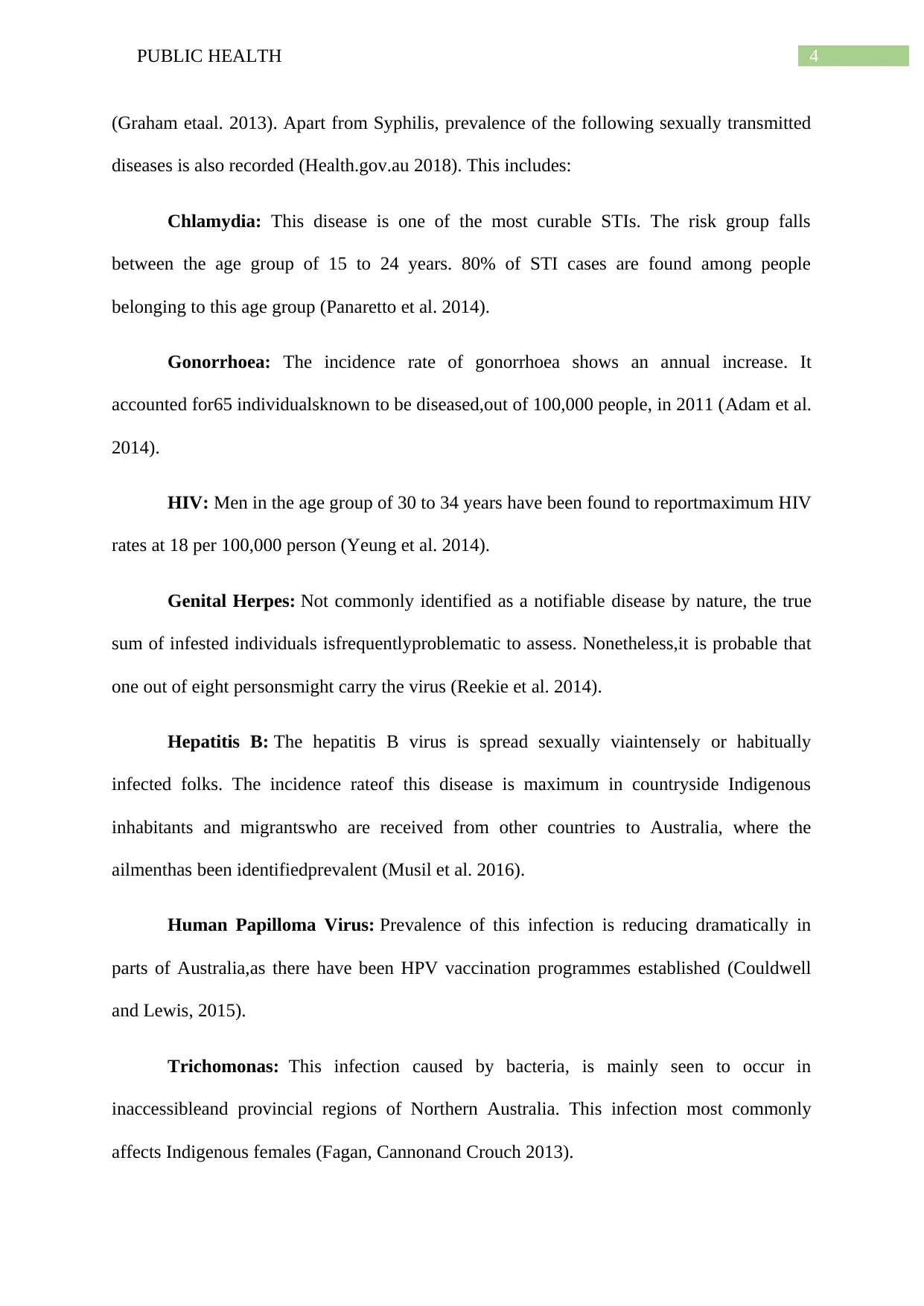
4PUBLIC HEALTH
(Graham etaal. 2013). Apart from Syphilis, prevalence of the following sexually transmitted
diseases is also recorded (Health.gov.au 2018). This includes:
Chlamydia: This disease is one of the most curable STIs. The risk group falls
between the age group of 15 to 24 years. 80% of STI cases are found among people
belonging to this age group (Panaretto et al. 2014).
Gonorrhoea: The incidence rate of gonorrhoea shows an annual increase. It
accounted for65 individualsknown to be diseased,out of 100,000 people, in 2011 (Adam et al.
2014).
HIV: Men in the age group of 30 to 34 years have been found to reportmaximum HIV
rates at 18 per 100,000 person (Yeung et al. 2014).
Genital Herpes: Not commonly identified as a notifiable disease by nature, the true
sum of infested individuals isfrequentlyproblematic to assess. Nonetheless,it is probable that
one out of eight personsmight carry the virus (Reekie et al. 2014).
Hepatitis B: The hepatitis B virus is spread sexually viaintensely or habitually
infected folks. The incidence rateof this disease is maximum in countryside Indigenous
inhabitants and migrantswho are received from other countries to Australia, where the
ailmenthas been identifiedprevalent (Musil et al. 2016).
Human Papilloma Virus: Prevalence of this infection is reducing dramatically in
parts of Australia,as there have been HPV vaccination programmes established (Couldwell
and Lewis, 2015).
Trichomonas: This infection caused by bacteria, is mainly seen to occur in
inaccessibleand provincial regions of Northern Australia. This infection most commonly
affects Indigenous females (Fagan, Cannonand Crouch 2013).
(Graham etaal. 2013). Apart from Syphilis, prevalence of the following sexually transmitted
diseases is also recorded (Health.gov.au 2018). This includes:
Chlamydia: This disease is one of the most curable STIs. The risk group falls
between the age group of 15 to 24 years. 80% of STI cases are found among people
belonging to this age group (Panaretto et al. 2014).
Gonorrhoea: The incidence rate of gonorrhoea shows an annual increase. It
accounted for65 individualsknown to be diseased,out of 100,000 people, in 2011 (Adam et al.
2014).
HIV: Men in the age group of 30 to 34 years have been found to reportmaximum HIV
rates at 18 per 100,000 person (Yeung et al. 2014).
Genital Herpes: Not commonly identified as a notifiable disease by nature, the true
sum of infested individuals isfrequentlyproblematic to assess. Nonetheless,it is probable that
one out of eight personsmight carry the virus (Reekie et al. 2014).
Hepatitis B: The hepatitis B virus is spread sexually viaintensely or habitually
infected folks. The incidence rateof this disease is maximum in countryside Indigenous
inhabitants and migrantswho are received from other countries to Australia, where the
ailmenthas been identifiedprevalent (Musil et al. 2016).
Human Papilloma Virus: Prevalence of this infection is reducing dramatically in
parts of Australia,as there have been HPV vaccination programmes established (Couldwell
and Lewis, 2015).
Trichomonas: This infection caused by bacteria, is mainly seen to occur in
inaccessibleand provincial regions of Northern Australia. This infection most commonly
affects Indigenous females (Fagan, Cannonand Crouch 2013).
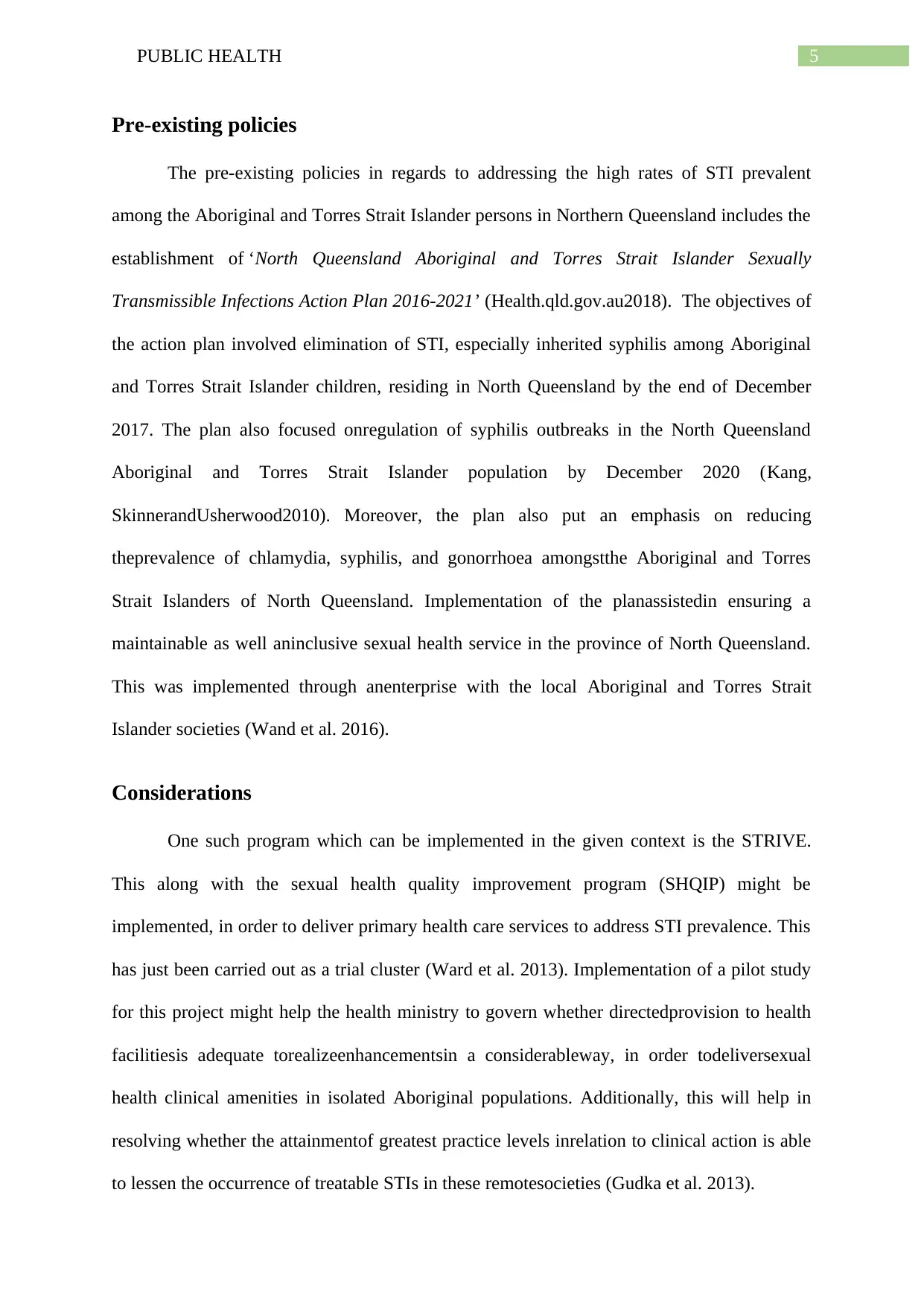
5PUBLIC HEALTH
Pre-existing policies
The pre-existing policies in regards to addressing the high rates of STI prevalent
among the Aboriginal and Torres Strait Islander persons in Northern Queensland includes the
establishment of ‘North Queensland Aboriginal and Torres Strait Islander Sexually
Transmissible Infections Action Plan 2016-2021’ (Health.qld.gov.au2018). The objectives of
the action plan involved elimination of STI, especially inherited syphilis among Aboriginal
and Torres Strait Islander children, residing in North Queensland by the end of December
2017. The plan also focused onregulation of syphilis outbreaks in the North Queensland
Aboriginal and Torres Strait Islander population by December 2020 (Kang,
SkinnerandUsherwood2010). Moreover, the plan also put an emphasis on reducing
theprevalence of chlamydia, syphilis, and gonorrhoea amongstthe Aboriginal and Torres
Strait Islanders of North Queensland. Implementation of the planassistedin ensuring a
maintainable as well aninclusive sexual health service in the province of North Queensland.
This was implemented through anenterprise with the local Aboriginal and Torres Strait
Islander societies (Wand et al. 2016).
Considerations
One such program which can be implemented in the given context is the STRIVE.
This along with the sexual health quality improvement program (SHQIP) might be
implemented, in order to deliver primary health care services to address STI prevalence. This
has just been carried out as a trial cluster (Ward et al. 2013). Implementation of a pilot study
for this project might help the health ministry to govern whether directedprovision to health
facilitiesis adequate torealizeenhancementsin a considerableway, in order todeliversexual
health clinical amenities in isolated Aboriginal populations. Additionally, this will help in
resolving whether the attainmentof greatest practice levels inrelation to clinical action is able
to lessen the occurrence of treatable STIs in these remotesocieties (Gudka et al. 2013).
Pre-existing policies
The pre-existing policies in regards to addressing the high rates of STI prevalent
among the Aboriginal and Torres Strait Islander persons in Northern Queensland includes the
establishment of ‘North Queensland Aboriginal and Torres Strait Islander Sexually
Transmissible Infections Action Plan 2016-2021’ (Health.qld.gov.au2018). The objectives of
the action plan involved elimination of STI, especially inherited syphilis among Aboriginal
and Torres Strait Islander children, residing in North Queensland by the end of December
2017. The plan also focused onregulation of syphilis outbreaks in the North Queensland
Aboriginal and Torres Strait Islander population by December 2020 (Kang,
SkinnerandUsherwood2010). Moreover, the plan also put an emphasis on reducing
theprevalence of chlamydia, syphilis, and gonorrhoea amongstthe Aboriginal and Torres
Strait Islanders of North Queensland. Implementation of the planassistedin ensuring a
maintainable as well aninclusive sexual health service in the province of North Queensland.
This was implemented through anenterprise with the local Aboriginal and Torres Strait
Islander societies (Wand et al. 2016).
Considerations
One such program which can be implemented in the given context is the STRIVE.
This along with the sexual health quality improvement program (SHQIP) might be
implemented, in order to deliver primary health care services to address STI prevalence. This
has just been carried out as a trial cluster (Ward et al. 2013). Implementation of a pilot study
for this project might help the health ministry to govern whether directedprovision to health
facilitiesis adequate torealizeenhancementsin a considerableway, in order todeliversexual
health clinical amenities in isolated Aboriginal populations. Additionally, this will help in
resolving whether the attainmentof greatest practice levels inrelation to clinical action is able
to lessen the occurrence of treatable STIs in these remotesocieties (Gudka et al. 2013).
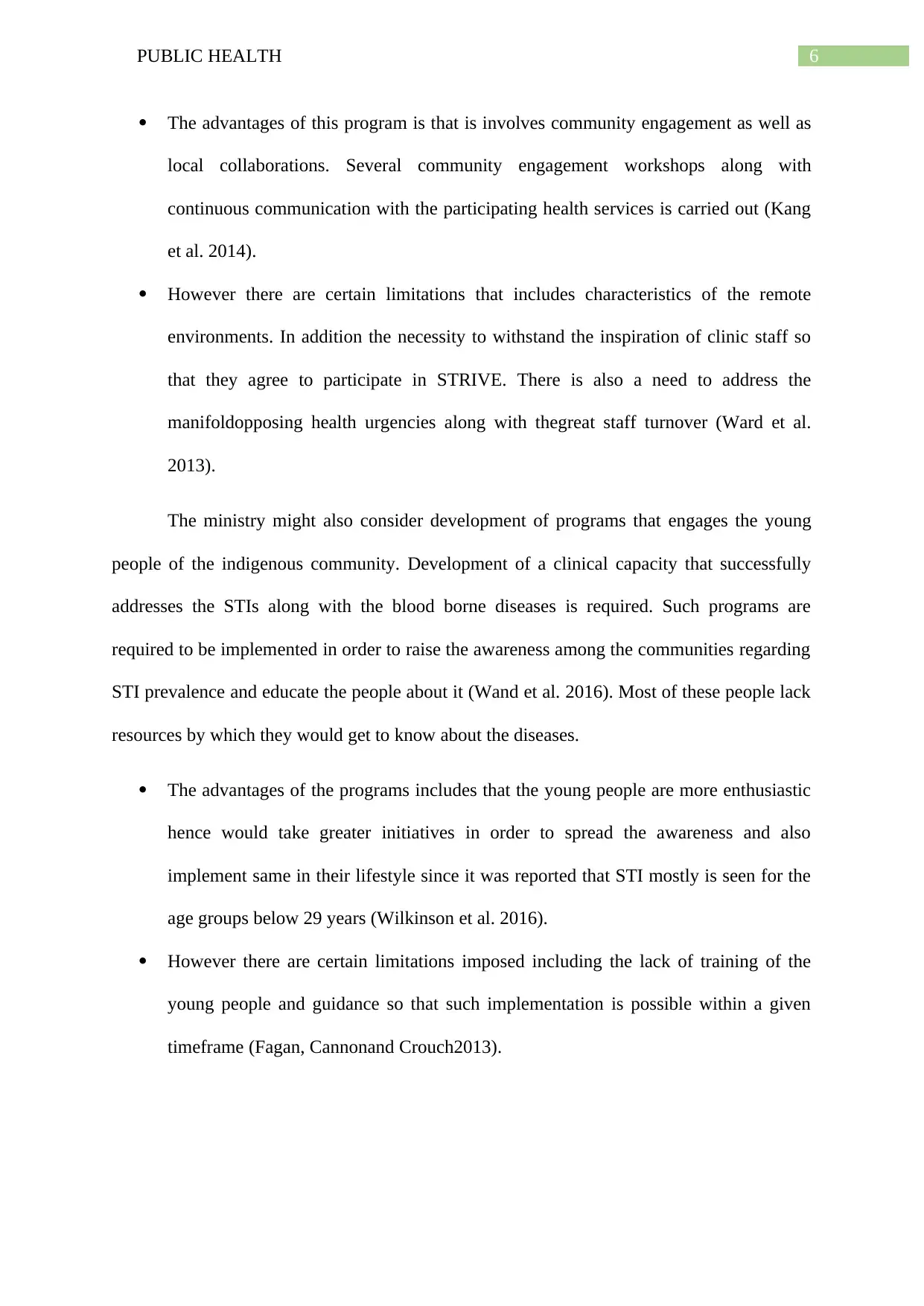
6PUBLIC HEALTH
The advantages of this program is that is involves community engagement as well as
local collaborations. Several community engagement workshops along with
continuous communication with the participating health services is carried out (Kang
et al. 2014).
However there are certain limitations that includes characteristics of the remote
environments. In addition the necessity to withstand the inspiration of clinic staff so
that they agree to participate in STRIVE. There is also a need to address the
manifoldopposing health urgencies along with thegreat staff turnover (Ward et al.
2013).
The ministry might also consider development of programs that engages the young
people of the indigenous community. Development of a clinical capacity that successfully
addresses the STIs along with the blood borne diseases is required. Such programs are
required to be implemented in order to raise the awareness among the communities regarding
STI prevalence and educate the people about it (Wand et al. 2016). Most of these people lack
resources by which they would get to know about the diseases.
The advantages of the programs includes that the young people are more enthusiastic
hence would take greater initiatives in order to spread the awareness and also
implement same in their lifestyle since it was reported that STI mostly is seen for the
age groups below 29 years (Wilkinson et al. 2016).
However there are certain limitations imposed including the lack of training of the
young people and guidance so that such implementation is possible within a given
timeframe (Fagan, Cannonand Crouch2013).
The advantages of this program is that is involves community engagement as well as
local collaborations. Several community engagement workshops along with
continuous communication with the participating health services is carried out (Kang
et al. 2014).
However there are certain limitations that includes characteristics of the remote
environments. In addition the necessity to withstand the inspiration of clinic staff so
that they agree to participate in STRIVE. There is also a need to address the
manifoldopposing health urgencies along with thegreat staff turnover (Ward et al.
2013).
The ministry might also consider development of programs that engages the young
people of the indigenous community. Development of a clinical capacity that successfully
addresses the STIs along with the blood borne diseases is required. Such programs are
required to be implemented in order to raise the awareness among the communities regarding
STI prevalence and educate the people about it (Wand et al. 2016). Most of these people lack
resources by which they would get to know about the diseases.
The advantages of the programs includes that the young people are more enthusiastic
hence would take greater initiatives in order to spread the awareness and also
implement same in their lifestyle since it was reported that STI mostly is seen for the
age groups below 29 years (Wilkinson et al. 2016).
However there are certain limitations imposed including the lack of training of the
young people and guidance so that such implementation is possible within a given
timeframe (Fagan, Cannonand Crouch2013).
Paraphrase This Document
Need a fresh take? Get an instant paraphrase of this document with our AI Paraphraser
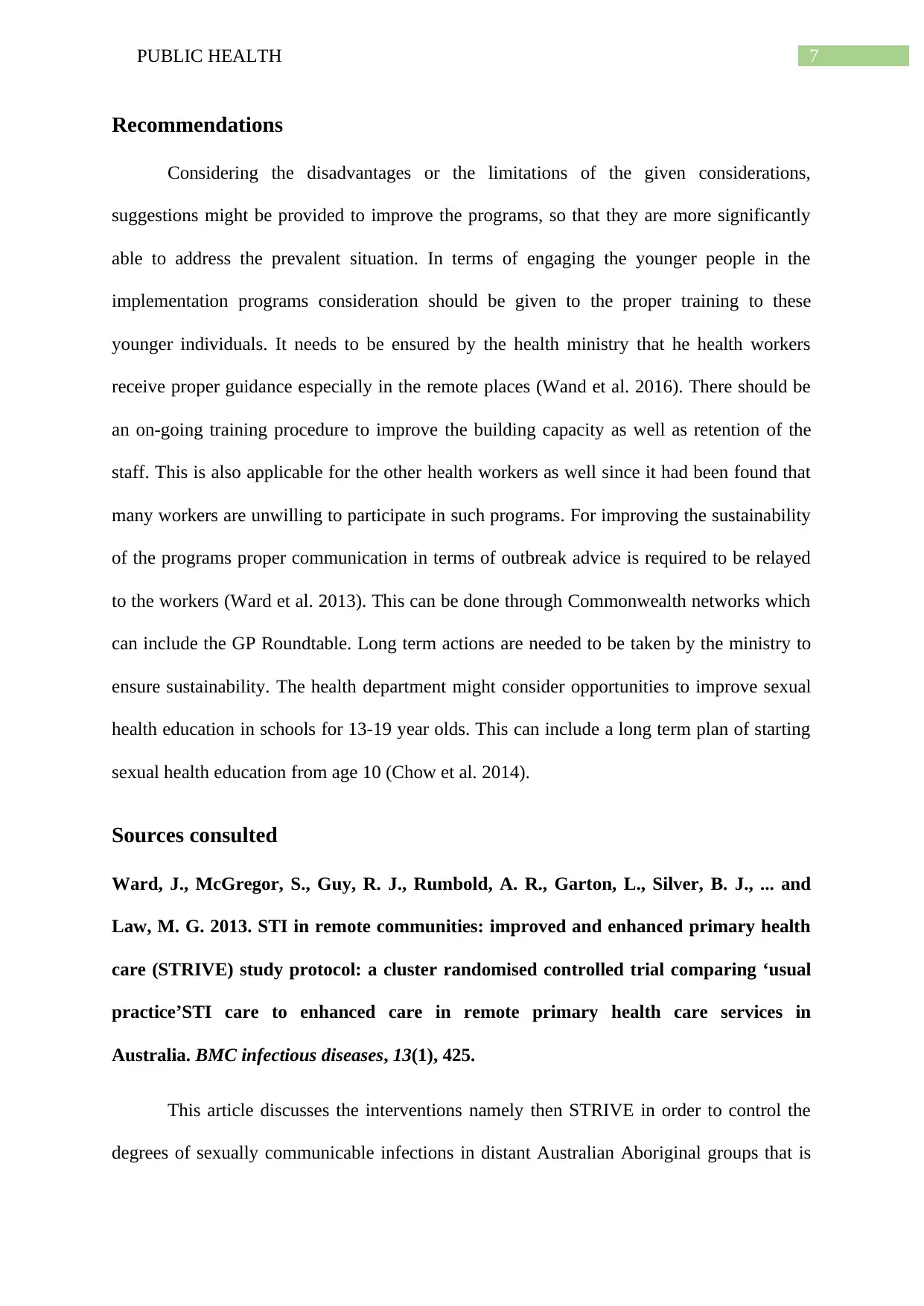
7PUBLIC HEALTH
Recommendations
Considering the disadvantages or the limitations of the given considerations,
suggestions might be provided to improve the programs, so that they are more significantly
able to address the prevalent situation. In terms of engaging the younger people in the
implementation programs consideration should be given to the proper training to these
younger individuals. It needs to be ensured by the health ministry that he health workers
receive proper guidance especially in the remote places (Wand et al. 2016). There should be
an on-going training procedure to improve the building capacity as well as retention of the
staff. This is also applicable for the other health workers as well since it had been found that
many workers are unwilling to participate in such programs. For improving the sustainability
of the programs proper communication in terms of outbreak advice is required to be relayed
to the workers (Ward et al. 2013). This can be done through Commonwealth networks which
can include the GP Roundtable. Long term actions are needed to be taken by the ministry to
ensure sustainability. The health department might consider opportunities to improve sexual
health education in schools for 13-19 year olds. This can include a long term plan of starting
sexual health education from age 10 (Chow et al. 2014).
Sources consulted
Ward, J., McGregor, S., Guy, R. J., Rumbold, A. R., Garton, L., Silver, B. J., ... and
Law, M. G. 2013. STI in remote communities: improved and enhanced primary health
care (STRIVE) study protocol: a cluster randomised controlled trial comparing ‘usual
practice’STI care to enhanced care in remote primary health care services in
Australia. BMC infectious diseases, 13(1), 425.
This article discusses the interventions namely then STRIVE in order to control the
degrees of sexually communicable infections in distant Australian Aboriginal groups that is
Recommendations
Considering the disadvantages or the limitations of the given considerations,
suggestions might be provided to improve the programs, so that they are more significantly
able to address the prevalent situation. In terms of engaging the younger people in the
implementation programs consideration should be given to the proper training to these
younger individuals. It needs to be ensured by the health ministry that he health workers
receive proper guidance especially in the remote places (Wand et al. 2016). There should be
an on-going training procedure to improve the building capacity as well as retention of the
staff. This is also applicable for the other health workers as well since it had been found that
many workers are unwilling to participate in such programs. For improving the sustainability
of the programs proper communication in terms of outbreak advice is required to be relayed
to the workers (Ward et al. 2013). This can be done through Commonwealth networks which
can include the GP Roundtable. Long term actions are needed to be taken by the ministry to
ensure sustainability. The health department might consider opportunities to improve sexual
health education in schools for 13-19 year olds. This can include a long term plan of starting
sexual health education from age 10 (Chow et al. 2014).
Sources consulted
Ward, J., McGregor, S., Guy, R. J., Rumbold, A. R., Garton, L., Silver, B. J., ... and
Law, M. G. 2013. STI in remote communities: improved and enhanced primary health
care (STRIVE) study protocol: a cluster randomised controlled trial comparing ‘usual
practice’STI care to enhanced care in remote primary health care services in
Australia. BMC infectious diseases, 13(1), 425.
This article discusses the interventions namely then STRIVE in order to control the
degrees of sexually communicable infections in distant Australian Aboriginal groups that is
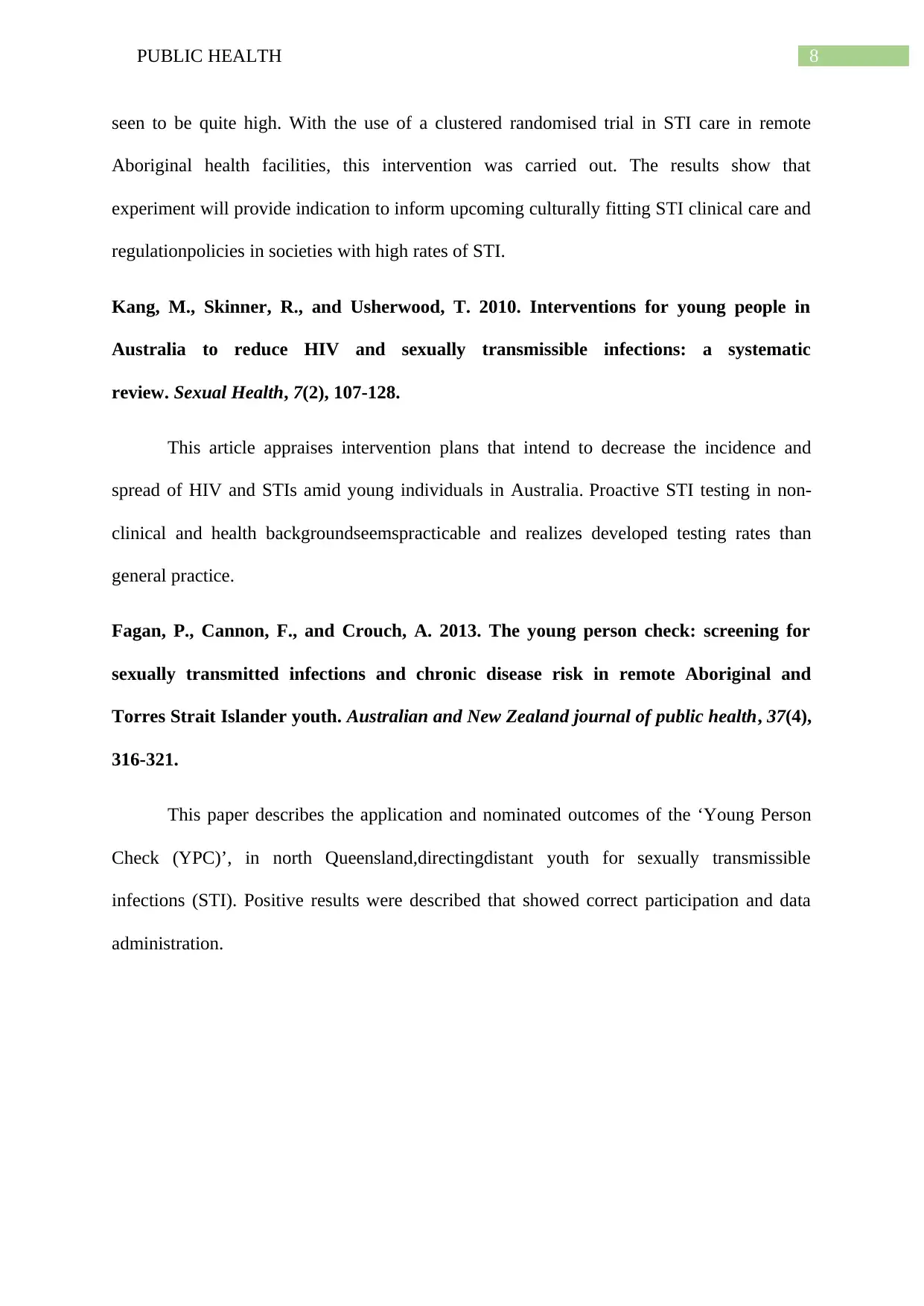
8PUBLIC HEALTH
seen to be quite high. With the use of a clustered randomised trial in STI care in remote
Aboriginal health facilities, this intervention was carried out. The results show that
experiment will provide indication to inform upcoming culturally fitting STI clinical care and
regulationpolicies in societies with high rates of STI.
Kang, M., Skinner, R., and Usherwood, T. 2010. Interventions for young people in
Australia to reduce HIV and sexually transmissible infections: a systematic
review. Sexual Health, 7(2), 107-128.
This article appraises intervention plans that intend to decrease the incidence and
spread of HIV and STIs amid young individuals in Australia. Proactive STI testing in non-
clinical and health backgroundseemspracticable and realizes developed testing rates than
general practice.
Fagan, P., Cannon, F., and Crouch, A. 2013. The young person check: screening for
sexually transmitted infections and chronic disease risk in remote Aboriginal and
Torres Strait Islander youth. Australian and New Zealand journal of public health, 37(4),
316-321.
This paper describes the application and nominated outcomes of the ‘Young Person
Check (YPC)’, in north Queensland,directingdistant youth for sexually transmissible
infections (STI). Positive results were described that showed correct participation and data
administration.
seen to be quite high. With the use of a clustered randomised trial in STI care in remote
Aboriginal health facilities, this intervention was carried out. The results show that
experiment will provide indication to inform upcoming culturally fitting STI clinical care and
regulationpolicies in societies with high rates of STI.
Kang, M., Skinner, R., and Usherwood, T. 2010. Interventions for young people in
Australia to reduce HIV and sexually transmissible infections: a systematic
review. Sexual Health, 7(2), 107-128.
This article appraises intervention plans that intend to decrease the incidence and
spread of HIV and STIs amid young individuals in Australia. Proactive STI testing in non-
clinical and health backgroundseemspracticable and realizes developed testing rates than
general practice.
Fagan, P., Cannon, F., and Crouch, A. 2013. The young person check: screening for
sexually transmitted infections and chronic disease risk in remote Aboriginal and
Torres Strait Islander youth. Australian and New Zealand journal of public health, 37(4),
316-321.
This paper describes the application and nominated outcomes of the ‘Young Person
Check (YPC)’, in north Queensland,directingdistant youth for sexually transmissible
infections (STI). Positive results were described that showed correct participation and data
administration.
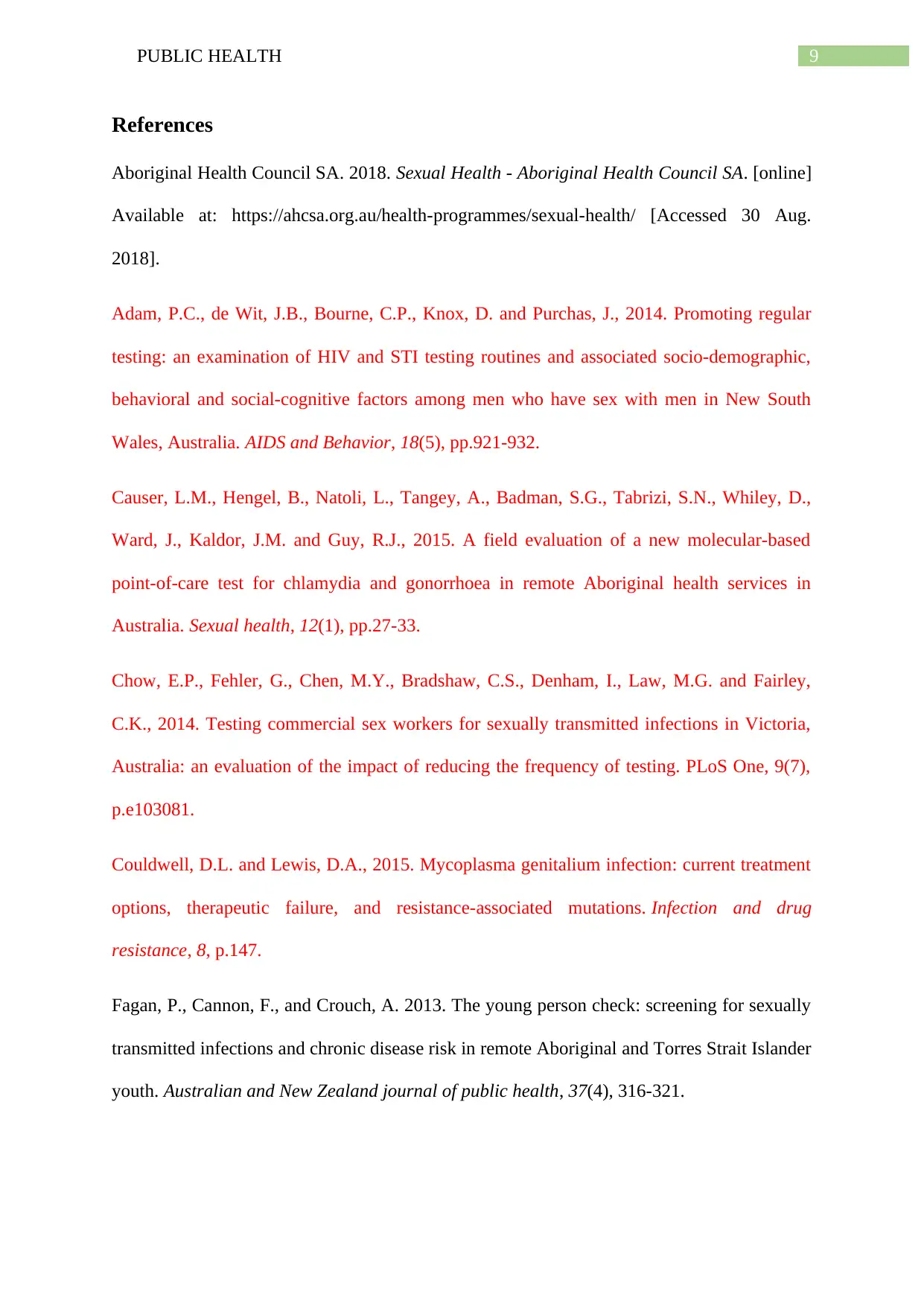
9PUBLIC HEALTH
References
Aboriginal Health Council SA. 2018. Sexual Health - Aboriginal Health Council SA. [online]
Available at: https://ahcsa.org.au/health-programmes/sexual-health/ [Accessed 30 Aug.
2018].
Adam, P.C., de Wit, J.B., Bourne, C.P., Knox, D. and Purchas, J., 2014. Promoting regular
testing: an examination of HIV and STI testing routines and associated socio-demographic,
behavioral and social-cognitive factors among men who have sex with men in New South
Wales, Australia. AIDS and Behavior, 18(5), pp.921-932.
Causer, L.M., Hengel, B., Natoli, L., Tangey, A., Badman, S.G., Tabrizi, S.N., Whiley, D.,
Ward, J., Kaldor, J.M. and Guy, R.J., 2015. A field evaluation of a new molecular-based
point-of-care test for chlamydia and gonorrhoea in remote Aboriginal health services in
Australia. Sexual health, 12(1), pp.27-33.
Chow, E.P., Fehler, G., Chen, M.Y., Bradshaw, C.S., Denham, I., Law, M.G. and Fairley,
C.K., 2014. Testing commercial sex workers for sexually transmitted infections in Victoria,
Australia: an evaluation of the impact of reducing the frequency of testing. PLoS One, 9(7),
p.e103081.
Couldwell, D.L. and Lewis, D.A., 2015. Mycoplasma genitalium infection: current treatment
options, therapeutic failure, and resistance-associated mutations. Infection and drug
resistance, 8, p.147.
Fagan, P., Cannon, F., and Crouch, A. 2013. The young person check: screening for sexually
transmitted infections and chronic disease risk in remote Aboriginal and Torres Strait Islander
youth. Australian and New Zealand journal of public health, 37(4), 316-321.
References
Aboriginal Health Council SA. 2018. Sexual Health - Aboriginal Health Council SA. [online]
Available at: https://ahcsa.org.au/health-programmes/sexual-health/ [Accessed 30 Aug.
2018].
Adam, P.C., de Wit, J.B., Bourne, C.P., Knox, D. and Purchas, J., 2014. Promoting regular
testing: an examination of HIV and STI testing routines and associated socio-demographic,
behavioral and social-cognitive factors among men who have sex with men in New South
Wales, Australia. AIDS and Behavior, 18(5), pp.921-932.
Causer, L.M., Hengel, B., Natoli, L., Tangey, A., Badman, S.G., Tabrizi, S.N., Whiley, D.,
Ward, J., Kaldor, J.M. and Guy, R.J., 2015. A field evaluation of a new molecular-based
point-of-care test for chlamydia and gonorrhoea in remote Aboriginal health services in
Australia. Sexual health, 12(1), pp.27-33.
Chow, E.P., Fehler, G., Chen, M.Y., Bradshaw, C.S., Denham, I., Law, M.G. and Fairley,
C.K., 2014. Testing commercial sex workers for sexually transmitted infections in Victoria,
Australia: an evaluation of the impact of reducing the frequency of testing. PLoS One, 9(7),
p.e103081.
Couldwell, D.L. and Lewis, D.A., 2015. Mycoplasma genitalium infection: current treatment
options, therapeutic failure, and resistance-associated mutations. Infection and drug
resistance, 8, p.147.
Fagan, P., Cannon, F., and Crouch, A. 2013. The young person check: screening for sexually
transmitted infections and chronic disease risk in remote Aboriginal and Torres Strait Islander
youth. Australian and New Zealand journal of public health, 37(4), 316-321.
Secure Best Marks with AI Grader
Need help grading? Try our AI Grader for instant feedback on your assignments.
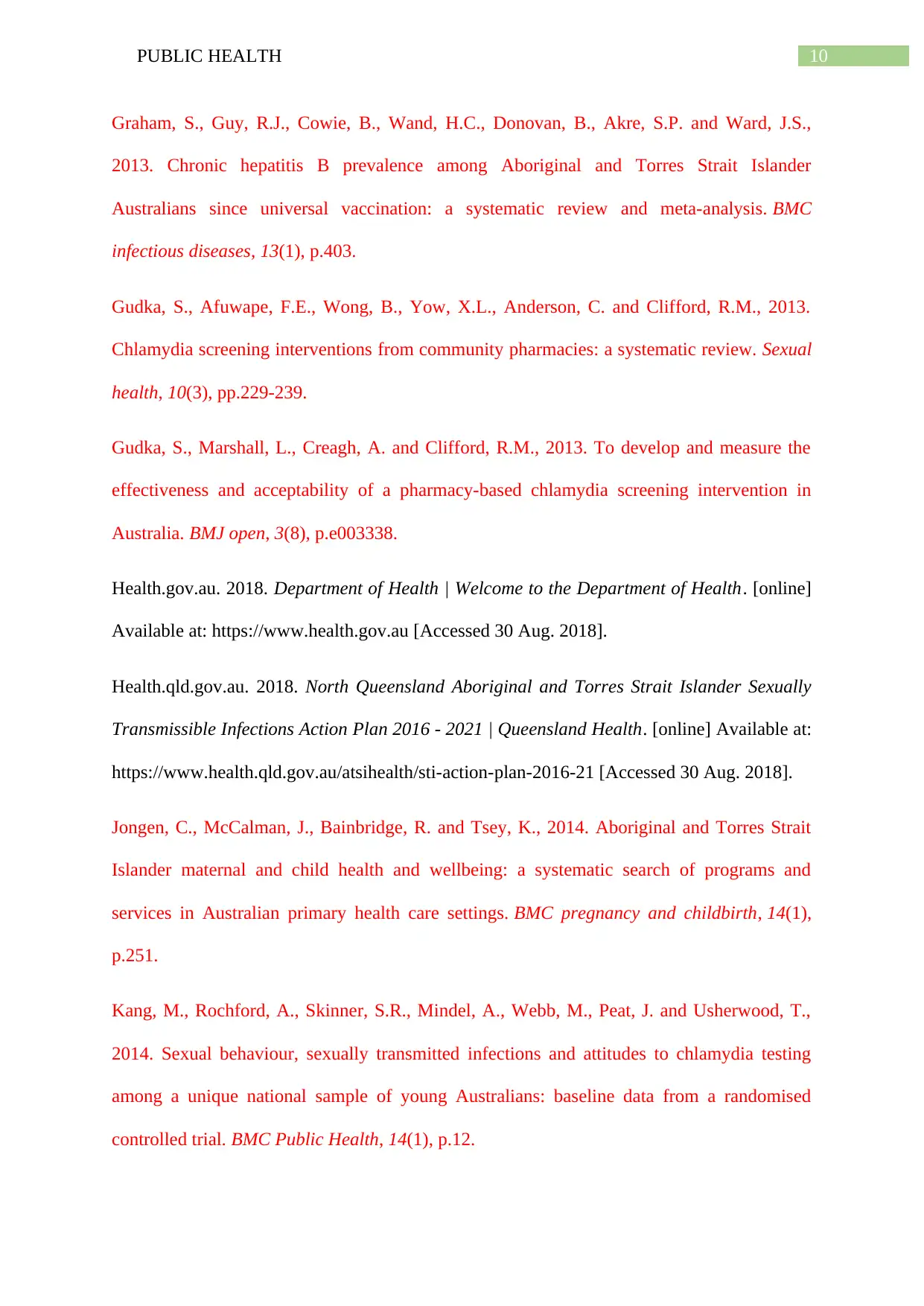
10PUBLIC HEALTH
Graham, S., Guy, R.J., Cowie, B., Wand, H.C., Donovan, B., Akre, S.P. and Ward, J.S.,
2013. Chronic hepatitis B prevalence among Aboriginal and Torres Strait Islander
Australians since universal vaccination: a systematic review and meta-analysis. BMC
infectious diseases, 13(1), p.403.
Gudka, S., Afuwape, F.E., Wong, B., Yow, X.L., Anderson, C. and Clifford, R.M., 2013.
Chlamydia screening interventions from community pharmacies: a systematic review. Sexual
health, 10(3), pp.229-239.
Gudka, S., Marshall, L., Creagh, A. and Clifford, R.M., 2013. To develop and measure the
effectiveness and acceptability of a pharmacy-based chlamydia screening intervention in
Australia. BMJ open, 3(8), p.e003338.
Health.gov.au. 2018. Department of Health | Welcome to the Department of Health. [online]
Available at: https://www.health.gov.au [Accessed 30 Aug. 2018].
Health.qld.gov.au. 2018. North Queensland Aboriginal and Torres Strait Islander Sexually
Transmissible Infections Action Plan 2016 - 2021 | Queensland Health. [online] Available at:
https://www.health.qld.gov.au/atsihealth/sti-action-plan-2016-21 [Accessed 30 Aug. 2018].
Jongen, C., McCalman, J., Bainbridge, R. and Tsey, K., 2014. Aboriginal and Torres Strait
Islander maternal and child health and wellbeing: a systematic search of programs and
services in Australian primary health care settings. BMC pregnancy and childbirth, 14(1),
p.251.
Kang, M., Rochford, A., Skinner, S.R., Mindel, A., Webb, M., Peat, J. and Usherwood, T.,
2014. Sexual behaviour, sexually transmitted infections and attitudes to chlamydia testing
among a unique national sample of young Australians: baseline data from a randomised
controlled trial. BMC Public Health, 14(1), p.12.
Graham, S., Guy, R.J., Cowie, B., Wand, H.C., Donovan, B., Akre, S.P. and Ward, J.S.,
2013. Chronic hepatitis B prevalence among Aboriginal and Torres Strait Islander
Australians since universal vaccination: a systematic review and meta-analysis. BMC
infectious diseases, 13(1), p.403.
Gudka, S., Afuwape, F.E., Wong, B., Yow, X.L., Anderson, C. and Clifford, R.M., 2013.
Chlamydia screening interventions from community pharmacies: a systematic review. Sexual
health, 10(3), pp.229-239.
Gudka, S., Marshall, L., Creagh, A. and Clifford, R.M., 2013. To develop and measure the
effectiveness and acceptability of a pharmacy-based chlamydia screening intervention in
Australia. BMJ open, 3(8), p.e003338.
Health.gov.au. 2018. Department of Health | Welcome to the Department of Health. [online]
Available at: https://www.health.gov.au [Accessed 30 Aug. 2018].
Health.qld.gov.au. 2018. North Queensland Aboriginal and Torres Strait Islander Sexually
Transmissible Infections Action Plan 2016 - 2021 | Queensland Health. [online] Available at:
https://www.health.qld.gov.au/atsihealth/sti-action-plan-2016-21 [Accessed 30 Aug. 2018].
Jongen, C., McCalman, J., Bainbridge, R. and Tsey, K., 2014. Aboriginal and Torres Strait
Islander maternal and child health and wellbeing: a systematic search of programs and
services in Australian primary health care settings. BMC pregnancy and childbirth, 14(1),
p.251.
Kang, M., Rochford, A., Skinner, S.R., Mindel, A., Webb, M., Peat, J. and Usherwood, T.,
2014. Sexual behaviour, sexually transmitted infections and attitudes to chlamydia testing
among a unique national sample of young Australians: baseline data from a randomised
controlled trial. BMC Public Health, 14(1), p.12.
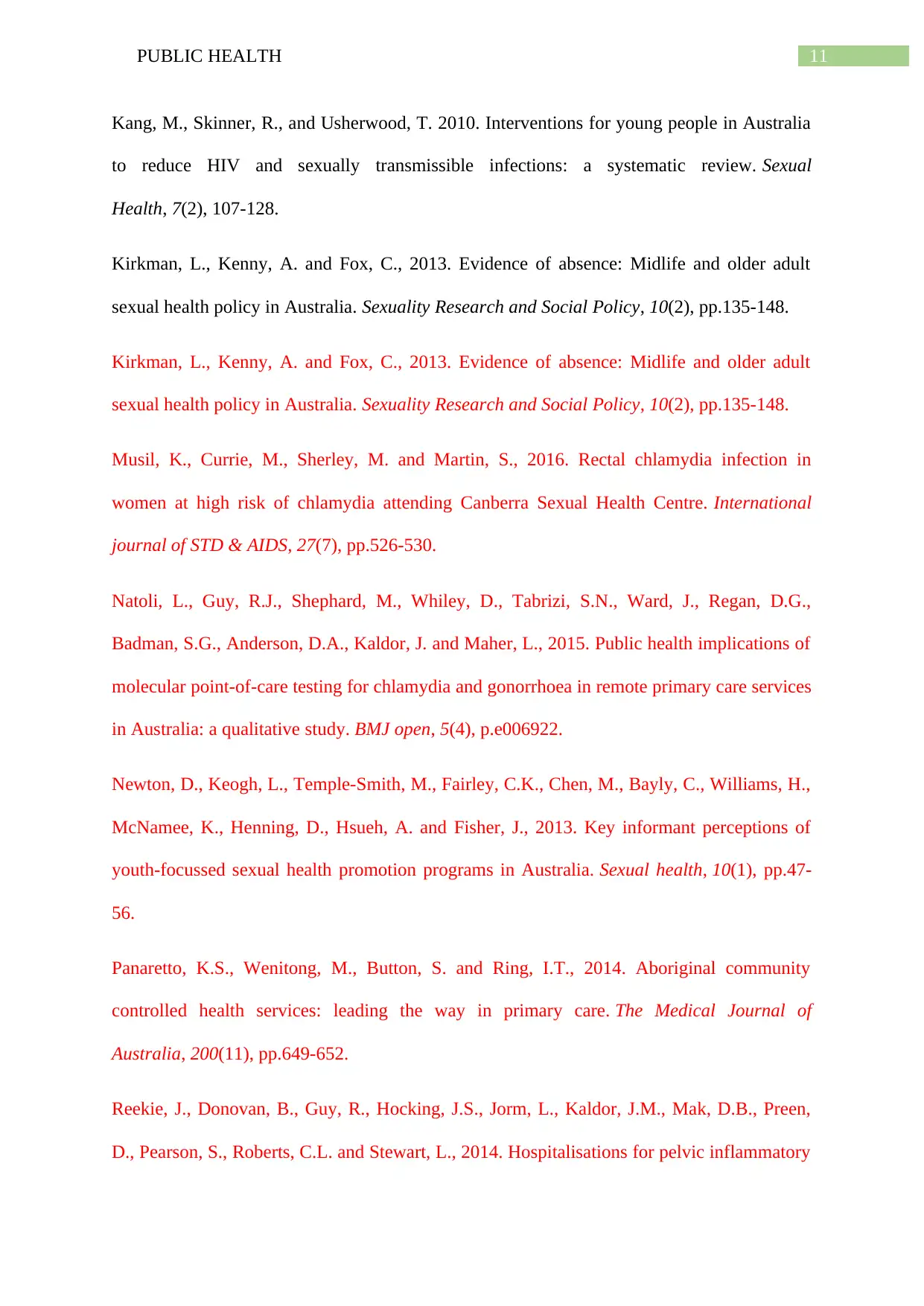
11PUBLIC HEALTH
Kang, M., Skinner, R., and Usherwood, T. 2010. Interventions for young people in Australia
to reduce HIV and sexually transmissible infections: a systematic review. Sexual
Health, 7(2), 107-128.
Kirkman, L., Kenny, A. and Fox, C., 2013. Evidence of absence: Midlife and older adult
sexual health policy in Australia. Sexuality Research and Social Policy, 10(2), pp.135-148.
Kirkman, L., Kenny, A. and Fox, C., 2013. Evidence of absence: Midlife and older adult
sexual health policy in Australia. Sexuality Research and Social Policy, 10(2), pp.135-148.
Musil, K., Currie, M., Sherley, M. and Martin, S., 2016. Rectal chlamydia infection in
women at high risk of chlamydia attending Canberra Sexual Health Centre. International
journal of STD & AIDS, 27(7), pp.526-530.
Natoli, L., Guy, R.J., Shephard, M., Whiley, D., Tabrizi, S.N., Ward, J., Regan, D.G.,
Badman, S.G., Anderson, D.A., Kaldor, J. and Maher, L., 2015. Public health implications of
molecular point-of-care testing for chlamydia and gonorrhoea in remote primary care services
in Australia: a qualitative study. BMJ open, 5(4), p.e006922.
Newton, D., Keogh, L., Temple-Smith, M., Fairley, C.K., Chen, M., Bayly, C., Williams, H.,
McNamee, K., Henning, D., Hsueh, A. and Fisher, J., 2013. Key informant perceptions of
youth-focussed sexual health promotion programs in Australia. Sexual health, 10(1), pp.47-
56.
Panaretto, K.S., Wenitong, M., Button, S. and Ring, I.T., 2014. Aboriginal community
controlled health services: leading the way in primary care. The Medical Journal of
Australia, 200(11), pp.649-652.
Reekie, J., Donovan, B., Guy, R., Hocking, J.S., Jorm, L., Kaldor, J.M., Mak, D.B., Preen,
D., Pearson, S., Roberts, C.L. and Stewart, L., 2014. Hospitalisations for pelvic inflammatory
Kang, M., Skinner, R., and Usherwood, T. 2010. Interventions for young people in Australia
to reduce HIV and sexually transmissible infections: a systematic review. Sexual
Health, 7(2), 107-128.
Kirkman, L., Kenny, A. and Fox, C., 2013. Evidence of absence: Midlife and older adult
sexual health policy in Australia. Sexuality Research and Social Policy, 10(2), pp.135-148.
Kirkman, L., Kenny, A. and Fox, C., 2013. Evidence of absence: Midlife and older adult
sexual health policy in Australia. Sexuality Research and Social Policy, 10(2), pp.135-148.
Musil, K., Currie, M., Sherley, M. and Martin, S., 2016. Rectal chlamydia infection in
women at high risk of chlamydia attending Canberra Sexual Health Centre. International
journal of STD & AIDS, 27(7), pp.526-530.
Natoli, L., Guy, R.J., Shephard, M., Whiley, D., Tabrizi, S.N., Ward, J., Regan, D.G.,
Badman, S.G., Anderson, D.A., Kaldor, J. and Maher, L., 2015. Public health implications of
molecular point-of-care testing for chlamydia and gonorrhoea in remote primary care services
in Australia: a qualitative study. BMJ open, 5(4), p.e006922.
Newton, D., Keogh, L., Temple-Smith, M., Fairley, C.K., Chen, M., Bayly, C., Williams, H.,
McNamee, K., Henning, D., Hsueh, A. and Fisher, J., 2013. Key informant perceptions of
youth-focussed sexual health promotion programs in Australia. Sexual health, 10(1), pp.47-
56.
Panaretto, K.S., Wenitong, M., Button, S. and Ring, I.T., 2014. Aboriginal community
controlled health services: leading the way in primary care. The Medical Journal of
Australia, 200(11), pp.649-652.
Reekie, J., Donovan, B., Guy, R., Hocking, J.S., Jorm, L., Kaldor, J.M., Mak, D.B., Preen,
D., Pearson, S., Roberts, C.L. and Stewart, L., 2014. Hospitalisations for pelvic inflammatory

12PUBLIC HEALTH
disease temporally related to a diagnosis of Chlamydia or gonorrhoea: a retrospective cohort
study. PloS one, 9(4), p.e94361.
Ritter, T., Dore, A. and McGeechan, K., 2015. Contraceptive knowledge and attitudes among
14–24‐year‐olds in New South Wales, Australia. Australian and New Zealand journal of
public health, 39(3), pp.267-269.
Walker, J., Walker, S., Fairley, C.K., Bilardi, J., Chen, M.Y., Bradshaw, C.S., Urban, E.,
Pirotta, M., Birden, H., Donovan, B. and Kaldor, J.M., 2013. What do young women think
about having a chlamydia test? Views of women who tested positive compared with women
who tested negative. Sexual Health, 10(1), pp.39-42.
Wand, H., Ward, J., Bryant, J., Delaney-Thiele, D., Worth, H., Pitts, M. and Kaldor, J.M.,
2016. Individual and population level impacts of illicit drug use, sexual risk behaviours on
sexually transmitted infections among young Aboriginal and Torres Strait Islander people:
results from the GOANNA survey. BMC public health, 16(1), p.600.
Ward, J., Bryant, J., Worth, H., Hull, P., Solar, S. and Bailey, S., 2013. Use of health services
for sexually transmitted and blood-borne viral infections by young Aboriginal people in New
South Wales. Australian journal of primary health, 19(1), pp.81-86.
Ward, J., Goller, J., Ali, H., Bowring, A., Couzos, S., Saunders, M., Yau, P., Kaldor, J.M.,
Hellard, M., Guy, R.J. and Donovan, B., 2014. Chlamydia among Australian Aboriginal
and/or Torres Strait Islander people attending sexual health services, general practices and
Aboriginal community controlled health services. BMC health services research, 14(1),
p.285.
Ward, J., McGregor, S., Guy, R. J., Rumbold, A. R., Garton, L., Silver, B. J., ... and Law, M.
G. 2013. STI in remote communities: improved and enhanced primary health care (STRIVE)
study protocol: a cluster randomised controlled trial comparing ‘usual practice’STI care to
disease temporally related to a diagnosis of Chlamydia or gonorrhoea: a retrospective cohort
study. PloS one, 9(4), p.e94361.
Ritter, T., Dore, A. and McGeechan, K., 2015. Contraceptive knowledge and attitudes among
14–24‐year‐olds in New South Wales, Australia. Australian and New Zealand journal of
public health, 39(3), pp.267-269.
Walker, J., Walker, S., Fairley, C.K., Bilardi, J., Chen, M.Y., Bradshaw, C.S., Urban, E.,
Pirotta, M., Birden, H., Donovan, B. and Kaldor, J.M., 2013. What do young women think
about having a chlamydia test? Views of women who tested positive compared with women
who tested negative. Sexual Health, 10(1), pp.39-42.
Wand, H., Ward, J., Bryant, J., Delaney-Thiele, D., Worth, H., Pitts, M. and Kaldor, J.M.,
2016. Individual and population level impacts of illicit drug use, sexual risk behaviours on
sexually transmitted infections among young Aboriginal and Torres Strait Islander people:
results from the GOANNA survey. BMC public health, 16(1), p.600.
Ward, J., Bryant, J., Worth, H., Hull, P., Solar, S. and Bailey, S., 2013. Use of health services
for sexually transmitted and blood-borne viral infections by young Aboriginal people in New
South Wales. Australian journal of primary health, 19(1), pp.81-86.
Ward, J., Goller, J., Ali, H., Bowring, A., Couzos, S., Saunders, M., Yau, P., Kaldor, J.M.,
Hellard, M., Guy, R.J. and Donovan, B., 2014. Chlamydia among Australian Aboriginal
and/or Torres Strait Islander people attending sexual health services, general practices and
Aboriginal community controlled health services. BMC health services research, 14(1),
p.285.
Ward, J., McGregor, S., Guy, R. J., Rumbold, A. R., Garton, L., Silver, B. J., ... and Law, M.
G. 2013. STI in remote communities: improved and enhanced primary health care (STRIVE)
study protocol: a cluster randomised controlled trial comparing ‘usual practice’STI care to
Paraphrase This Document
Need a fresh take? Get an instant paraphrase of this document with our AI Paraphraser
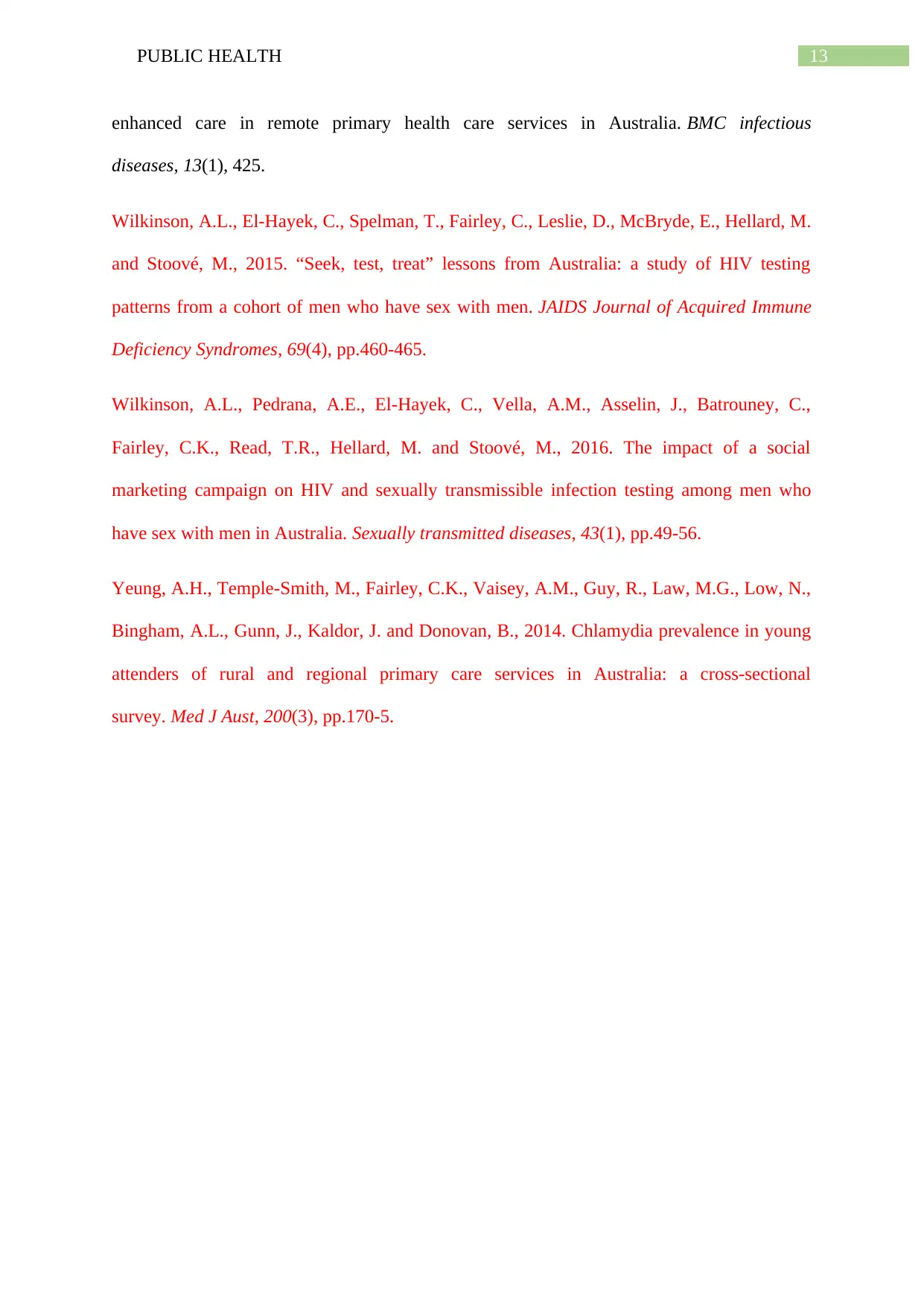
13PUBLIC HEALTH
enhanced care in remote primary health care services in Australia. BMC infectious
diseases, 13(1), 425.
Wilkinson, A.L., El-Hayek, C., Spelman, T., Fairley, C., Leslie, D., McBryde, E., Hellard, M.
and Stoové, M., 2015. “Seek, test, treat” lessons from Australia: a study of HIV testing
patterns from a cohort of men who have sex with men. JAIDS Journal of Acquired Immune
Deficiency Syndromes, 69(4), pp.460-465.
Wilkinson, A.L., Pedrana, A.E., El-Hayek, C., Vella, A.M., Asselin, J., Batrouney, C.,
Fairley, C.K., Read, T.R., Hellard, M. and Stoové, M., 2016. The impact of a social
marketing campaign on HIV and sexually transmissible infection testing among men who
have sex with men in Australia. Sexually transmitted diseases, 43(1), pp.49-56.
Yeung, A.H., Temple-Smith, M., Fairley, C.K., Vaisey, A.M., Guy, R., Law, M.G., Low, N.,
Bingham, A.L., Gunn, J., Kaldor, J. and Donovan, B., 2014. Chlamydia prevalence in young
attenders of rural and regional primary care services in Australia: a cross-sectional
survey. Med J Aust, 200(3), pp.170-5.
enhanced care in remote primary health care services in Australia. BMC infectious
diseases, 13(1), 425.
Wilkinson, A.L., El-Hayek, C., Spelman, T., Fairley, C., Leslie, D., McBryde, E., Hellard, M.
and Stoové, M., 2015. “Seek, test, treat” lessons from Australia: a study of HIV testing
patterns from a cohort of men who have sex with men. JAIDS Journal of Acquired Immune
Deficiency Syndromes, 69(4), pp.460-465.
Wilkinson, A.L., Pedrana, A.E., El-Hayek, C., Vella, A.M., Asselin, J., Batrouney, C.,
Fairley, C.K., Read, T.R., Hellard, M. and Stoové, M., 2016. The impact of a social
marketing campaign on HIV and sexually transmissible infection testing among men who
have sex with men in Australia. Sexually transmitted diseases, 43(1), pp.49-56.
Yeung, A.H., Temple-Smith, M., Fairley, C.K., Vaisey, A.M., Guy, R., Law, M.G., Low, N.,
Bingham, A.L., Gunn, J., Kaldor, J. and Donovan, B., 2014. Chlamydia prevalence in young
attenders of rural and regional primary care services in Australia: a cross-sectional
survey. Med J Aust, 200(3), pp.170-5.
1 out of 14
Related Documents
Your All-in-One AI-Powered Toolkit for Academic Success.
+13062052269
info@desklib.com
Available 24*7 on WhatsApp / Email
![[object Object]](/_next/static/media/star-bottom.7253800d.svg)
Unlock your academic potential
© 2024 | Zucol Services PVT LTD | All rights reserved.





